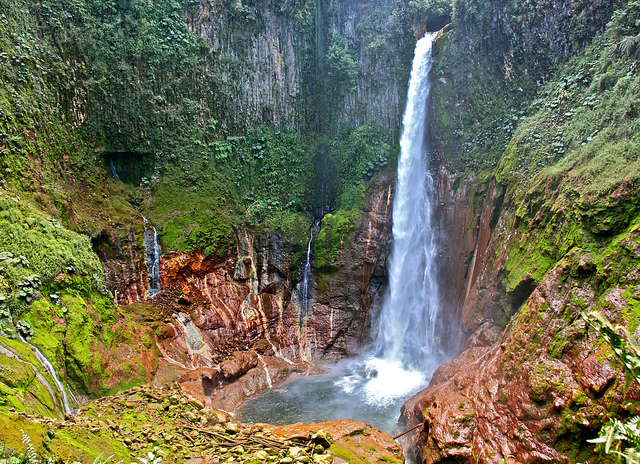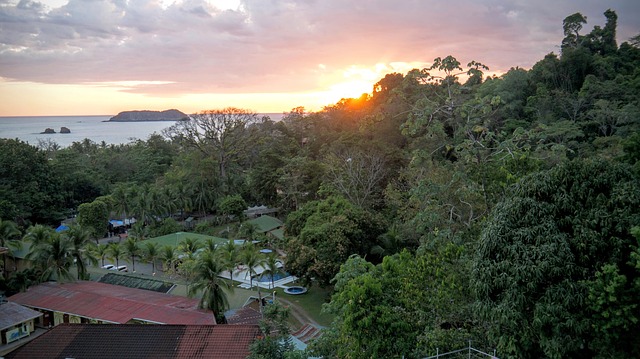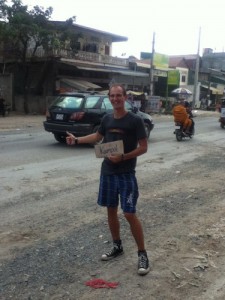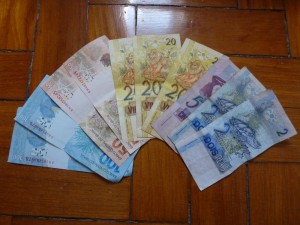Backpacking in Costa Rica
Backpackers who want to visit a country in Central America choose Costa Rica in the vast majority of cases. The country is the classic backpacker entry country in the region. And rightly so. First of all, you can expect a stunning nature and super horny beaches plus a fascinating biodiversity. On the other hand, travelling in Costa Rica is very safe and comfortable.
This also seems to have something to do with the mentality of the Costa Ricans. After all, what country does without an army? But there is also a small catch, in Switzerland of Central America, as Costa Rica is also called. And that would be the prices. We take a look at what there is to discover for backpackers in Costa Rica and how it is with travel costs.
Costa Rica – what one should know
You are visiting a country that is blessed with fertile soils. The reason for this is the mineral-rich volcanic ash, which allows a strong plant growth. Do you know that Costa Rcia has the lowest illiteracy rate in Latin America? Also interesting to know is that the dream destination Isla del Coco is the largest uninhabited island in the world. And another hammer. The Poás volcano can call the second largest crater of the world its own.
In Costa Rica it is also possible to see the Atlantic and the Pacific at the same time from the mountain peaks in the interior. This is nowhere else possible. Central American Switzerland, with its 4.5 million inhabitants, has completely dissolved its armed forces. That was in 1949. And unfortunately no other country copied it – where we all would have needed it so much.
Species-rich biodiversity in Costa Rica
If you are ever shown an orchid called Guaria Morada, it is the national flower of the country. Hardly any other country can refer to so many protected zones in relation to its area as Costa Rica. More than 30 percent of the terrains are national parks or other protected areas.

Backpacking in Costa Rica – Sunset
The area of this small country is just over 50,000 km2 (Germany 357,021 km²) – and now it’s coming: because you’ll find 5% of the world’s total flora and fauna species there. Concentrated nature awaits you. Alone 2000 different kinds of orchids are at home. Plus hundreds of butterfly species in all shades of colour and more than 900 bird species. That’s more than all of North America and Europe put together. The star among the birds is the almost extinct Quetzal.
Did you know that Pacific beaches are generally darker than Atlantic beaches? Volcanic ash also plays an important role here. The Pacific coast is much more stable than the other side in terms of climate. Therefore, there are also some exciting tourist destinations. Black is the Jacó beach in the province Puntarenas or also the Playa Espadilla in the national park Manuel Antonio.
If you want to experience fire-breathing volcanoes, the Arenal is waiting for you. It is considered the second most active volcano on the globe. Best at night. Great photos are guaranteed.
The best spots in Costa Rica you can’t miss are the Reserva de Bosque Nuboso de Monteverde, where you’ll find 3,000 different animal and plant species.
Beauty and relax, and here and there you can party on the beaches Tamarindo, Playa Langosta and Playa Grande. You can watch the sea turtles laying their eggs in the Parque Nacional Tortuguero. A lot of nature and fantastic beaches await you in Montezuma, which is close to the Parque Nacional Cabo Blanco, the Isla Tortuga and the Reserva de Vida Silvestre Curu. A quite varied nightlife awaits you in the capital San José.
Typical culture Costa Rica
In the country, the locals still get up with the chickens and go into the box at sunset. This is called a regular daily routine. Join in and your body will benefit more than in any spa. Otherwise the culture of the country as in all South and Central American countries is based on different influences, which came with the different waves of immigrants into the country and have mixed with the indigenous culture in the course of time.
Costa Rica is known for its indigenous masks, which are made of natural materials. A great souvenir, by the way, is a Rueda de carreta. These are round or square coloured plates made of natural materials on which the coffee beans were once transported. The Costa Ricans are called Ticos. This is no insult, but stands for peace, ambition and simplicity.
Backpacker Route in Costa Rica
There are plenty of backpacker routes for Costa Rica. The country is small but has a lot to offer because of its geographical diversity. Costa Rica is not Brazil, but you can spend a few weeks, if not months, in the country and always discover something new.
Es gibt viele Backpacker-Routen für Costa Rica. Das Land ist klein, hat aber aufgrund seiner geografischen Vielfalt viel zu bieten. Costa Rica ist nicht Brasilien, aber man kann ein paar Wochen, wenn nicht Monate im Land verbringen und immer etwas Neues entdecken.
As mentioned above, you can lengthen or shorten the route as you wish. It is always important how you want to travel, what you want to see and experience and of course if you can finance it.
Route 1: The classic (15-20 days)
- 2-3 days experience the capital San Jose with its multifaceted nightlife
- 2 days rain and swamp forests of the Tortuguero National Park
- 2-3 days to explore the Parque Nacional Volcan Arenal from the village of La Fortuna
- 3 days north coast with Tamarindo, Playa Langosta and Playa Grande enjoying
- 3 days Manuel Antonio and Parque Nacional Manuel Antonio comb through
- 2-3 days experience cloud forests in the Reserva de Bosque Nuboso de Monteverde
Route 2: All or Nothing (32-42 days)
First check out the destinations mentioned in Route 1
- 3 days on the peninsula Osa to get to know the Parque Nacional Corcovad
- 3 days in the fishing village of Santa Teresa, located on the Nicoya peninsula, to get to know the life of the locals.
- 8 days from Montezuma to explore the Parque Nacional Cabo Blanco, the Isla Tortuga and the Reserva de Vida Silvestre Curu.
- Experience 4 days of trekking and adventure at the Parque Nacional Cahuita, easily accessible from nearby Puerto Viejo.
- 2 days surfing and swimming on the beaches of Nosara and Playa Guiones.
- 1 day enjoy the museum variety of Costa Rica It is worthwhile to visit the Museo Nacional de Costa Rica (National Museum) in San Jose. Also a side trip to the Jade Museum “Marco Fidel Tristán Castro” is recommended.
- 4 days diving and snorkeling in front of Isla del Coco (coconut island) and Isla del Cano in front of Drake Bay.
Travel times in Costa Rica
Talking about the climate in Costa Rica is pointless, as there are pleasant temperatures all year round due to the proximity to the equator. In the highlands it can get a bit colder, but in the plains and on the beaches it is always warm. It is important to distinguish between the rain and the dry season. The rainy season begins in May and ends in mid-November. The dry season then extends over the rest of the year from December to April. It is important to know that you travel much cheaper in the low season. The average temperature in the capital San José is well over 20 degrees in the year.
Backpacker Budget in Costa Rica
It is not cheap to travel in Costa Rica. Adjust to Western European prices so roughly. However, you get something for it also offered. And if you are looking, you will always find an inexpensive place. Sao Paulo is the most expensive city in South America, San Jose is the counterpart in Central America. Nevertheless you can find hostels where you can spend the night for 10 to 15 dollars.
Couchsurfing is only possible in densely populated areas, but there is less to do in terms of nature. You can save money by going back to the local food in small pubs or at stalls. The so-called Sodas are very cheap. A short overview of the cost of living in the capital gives more detailed information about the prices. Everything in local currency, the Colón whose symbol is ₡.
- Daily average cost per capita around 40 euros
- Accommodation between 12 and 30 Euro
- Food 5 Euro
- Water: 1,4 Euro
- Local transport: 5 Euro
- Intercity Transport: 8 Euro
- Pizza: 2 Euro
- Rent a bike 3 Euro
You should calculate between 20 and 40 Euro per day. Inland you can easily travel with cheap public transport. A bus route in the city costs no more than a button and an egg. Microbuses are slightly more expensive. Domestic flights should be considered less, because there is always a lot to see on the overland trips. The longest flight time is less than an hour.
Whoever takes the “la Maria” does not get on a woman but in a taxi. Check if the taximeter is switched on. In contrast to other countries in the region, the Aventón is very popular. This is nothing more than getting your fingers out and stopping your car. There is only one tourist train, which is however rather a fun. It starts every now and then from the capital. All bus departure times for the international connections throughout Central America can be found at horariodebuses.com or you can have a look at the website of Ticabus. Other transport companies are Transnica and NicaExpresso, which connect Nicaragua and Costa Rica.
Backpacker accomodation in Costa Rica
In a country like Costa Rica, which has something to offer for every type of traveller, there is also a multifaceted selection of accommodation options. Those who prefer a stay in a sophisticated 5 star hotel can do so as well as travellers who are looking for a bed in a simple lodge or hostel.
However, the beds are not quite so cheap. Costa Rica has a good tourist infrastructure and the prices depend on it. Under 10 Euro it becomes already damn hard to find an accommodation. From 20 Euro there is a clean double room in a small guesthouse outside the main travel season.
Of course there are hardly any upper limits. You can look around for nice cabañas, which are quite cheap and often located close to the beach or in or at the edges of the national parks. The sophisticated eco-lodges, on the other hand, are rarely something for the traveler budget because of their high standards. But one or the other deal can already be there. Let’s have a look at how much on average a bed in a dorm of a mediocre hostel costs in the different places according to Hostelworld.
- 10 Euro San Jose
- 8 Euro La Fortuna
- 5 Euro Monteverde
- 11 Euro Manuel Antonio
- 14 Euro Alajuela
- 9 Euro Jaco
- 12 Euro Tamarindo
- 8-9 Euro Puerto Viejo
- 8 Euro Liberia
As I said not cheap, but also not unaffordable. Camping is possible in Costa Rica, but because of the lack of offers is hardly used. Also, one should not get the idea to camp wild in the national parks. Good campsites in breathtaking places are the Junquillal Bay Wildlife Refuge, the Brasilito Lodge, Camping Mora at Playa Carrillo, the campsite in Arenal Volcano National Park, Pension Santa Elena (hostel including campsite), the Truchas Selva Madre Camp at Cerro de la Muerte, the Vista Drake Hostel with campsite in Bahia Drake and the fantastic campsite at Playa Josecito.
Backpacker Trips, Tips & Highlights in Costa Rica
An absolute must is an excursion into the cloudy forests of the Reserva de Bosque Nuboso de Monteverde. You can forget your clothes because the humidity is 100%. Swim trunks do it too. More than 3000 species live there. A trip to the National Park Volcan Arenal y La Fortuna is similarly attractive. The fire-breathing volcano has it especially at night in itself. It is best to take a break from the small village La Fortuna and take a bath in one of the thermal baths.
On the northern Pacific coast, two real dream beaches with crystal clear waters await you. The two playas are called Playa Langosta and Playa Grande. Both are located around the town of Tamarindo.
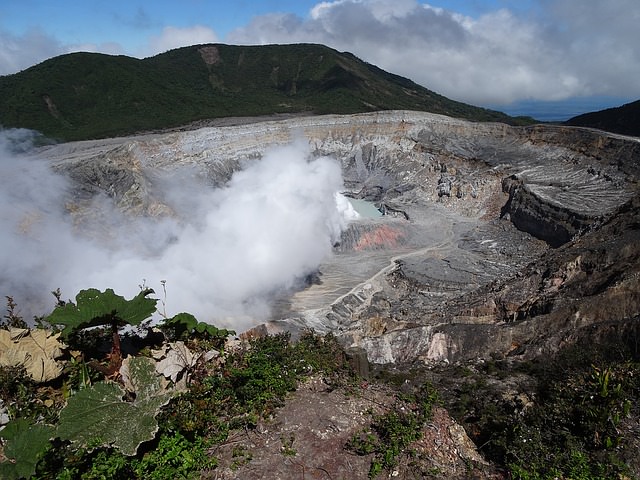
Backpacking in Costa Rica – Volcano Poas
Adventurous National Parks in Costa Rica
After a long descent you can then head for the small Manuel Antonio National Park. Trekking, clear and much more adventure is on the agenda. The Parque Nacional Tortuguero is one of the most exciting national parks, but only at a certain time of the year. Four out of eight Caribbean sea turtle species lay their eggs here.
Also the Manati is here beside many snakes and other reptiles resident. Another national park worth seeing on the Osa peninsula is the Corcovado Park. It is considered to be one of the richest in species on earth. If you are there, you can continue straight away to the Bahia Drake bay, where there is no less teeming with species of all kinds.
Surfing on Costa Rica’s dream beaches
Once you’ve had enough of trekking and all the cattle and want to relax, the small village of Santa Teresa in the south of the Nicoya peninsula with its dream beaches invites you to stay and hang out. Surfers get their money’s worth. A little further south the beaches of Mal Pais stretch out. Also a dream. Also on the peninsula Nicoya is the small village Montezuma, but in the south. The former sleepy fisherman’s nest is today the starting point for the trips to the Blanco National Park, a boat trip to the Isla Tortuga and the entrance to the Silvestre Curu reserve.
You can surf great around Puerto Viejo. Diving is also cool, because of the many coral reefs. Some of the most beautiful and distant playas are located. The best example is Playa Guiones.
Backpacker Insider Tips in Costa Rica
Near the Rio Pacuare you will find a region that is still very little visited by travelers. There in the dense rainforest along the river you can visit the indigenous people of the Cabecar tribe. You can even fly over the rainforest on a wire rope. Also worth seeing are the waterfalls of the Río Pacuare. It doesn’t look much different along the Río Celeste, which meanders through an impenetrable jungle. From the river there are paths leading up to the volcano Tenorio, which is no longer active (but maybe active).
You can be prepared for a hard trip, as the four cones and two twin craters are at an altitude of just under 2000m. Geisirs and thermal pools can be found everywhere along the paths. You should definitely take a photo of the Río Celeste. Celeste means: sky blue. And this is the river because of the many chemical elements it contains. Worth seeing is the Laguna azul embedded in the jungle and you can see at the “Borbollones” how gases from the earth’s crust bubble up into the water.
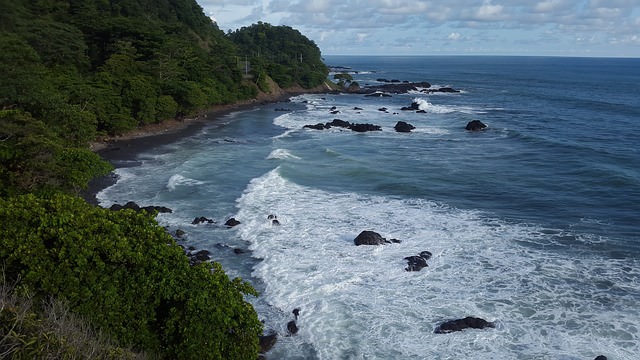
Backpacking in Costa Rica
The absolute natural highlight for water sports enthusiasts is the Isla de Coco. However, one only gets to this if one invests something. Already the diving hero Jaques Cousteau was out and about of the multifaceted underwater world around the island. The island is located 494 km off the Pacific coast of Costa Rica. Almost everywhere the island drops steeply into the sea. Swimming is only possible on a few beaches. Diving for it everywhere. You dive according to Padi in one of the 10 best divespots of the world. You can see hammerhead sharks, sea turtles or giant manta rays.
If you want to see Mono Titi, the cute monkey threatened with extinction, you have to go to the Parque Nacional de Manuel Antonio.
Food & Drinks in Costa Rica
As in all of Latin America, Costa Rica’s cuisine is influenced by many factors. At first, the local cuisine was dominated by Spanish, indigenous and African influences, later, in the course of various waves of immigration, other European influences were added. Almost everything that the local terrain has to offer is packed into the national dishes. And this is due to the preferred climate a lot.
The dishes on offer are based on corn, beans, potatoes and yuca and are seasoned and enriched with ingredients such as ayote, tomatoes, chayote, aguacate, pejibaye, palm hearts, chili dulce (sweet), chili picante (hot) and many more. The Empanada de Chiverre is a typical dish that combines the many roots of different nationalities. You take Spanish wheat, mix it with indigenous Cucurbita ficifolia and refine it with sugar from various other regions. That’s how it used to be.
Today, the products are sold where they are cheapest on the market. If you are offered a Salsa Lizano, then it is based on pure indigenous herbs – provided it is originally prepared. If you read the name Melcochon somewhere in a bakery or a supermarket, then this is not a biblical ancestor father for sale, but a simple baguette. What you could see every day on a local’s table are tortillas de maíz. Or different sausages like gallos de salchichón or chorizos.
The national dish is called Gallo Pinto and is prepared from rice, beans and eggs. Such a real backpacker hack-the-belly-full meal for little money. Also Guacamole you must try once. Sure, in Costa Rica you shouldn’t miss a good cup of coffee. The best coffee beans grow in the climatically optimal altitudes. A nice souvenir are the baskets woven from natural products, which are used to harvest the coffee beans.
Drinks in Costa Rica
In Costa Rica you can get drunk with tropical fruit juices. If you want to clap your way away cheaply, grab the sugar cane schnapps that’s everywhere. But be careful. The day after can be devastating. A delicious cocktail drink is the Guaro Sour. There are also numerous beers. Some are even really good, because they are produced in small companies in the traditional way.
The Cerveza Segua is such a beer, which convinces by quality. You shouldn’t believe it, but wine is also produced in Costa Rica. Not necessarily from grapes, but from berries and oranges. Sidra or cider is made from apples. At Christmas one drinks traditionally Rompope.
Backpacker Visum and Vaccination in Costa Rica
Entry requirements and visas in Costa Rica according to the data from the Foreign Office.
Entry is possible for German citizens with the following documents:
- Passport: Yes
- Temporary passport: Yes (visa required for transit via the USA!)
- Identity card: No
- Temporary identity card: No
- Children’s passport: Yes, only with photo (visa required for transit via the USA!)
Comments: All travel documents must be in good condition and valid for at least 180 days beyond the date of entry.
Children’s entries in a parent’s passport are no longer valid as of 26.06.2012. Each child needs his or her own identity document.
Visa
Germans can enter Costa Rica for tourist purposes for up to 90 days with a visa-free passport.
Vaccinations & medical advice
No vaccinations are required for direct entry from Germany. If you are entering from a yellow fever area, proof of a valid yellow fever vaccination is required.
Vaccinations against tetanus, diphtheria, possibly also against pertussis, mumps, measles, rubella and influenza should be made.
Hepatitis A is recommended as travel vaccinations, and also hepatitis B, rabies and typhoid fever for long-term stays or special exposure.
Malaria, Chikungunya, Dengue and Leishmaniasis are not unknown in Costa Rica.

